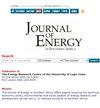Investigation of Wind Data Resolution for Small Wind Turbine Performance Study
IF 0.6
4区 工程技术
Q4 ENERGY & FUELS
引用次数: 0
Abstract
Small wind turbine sites, in general, use a 0.5Hz sampling interval and a 10-minute averaging interval for a feasibility study or turbine testing. Studies have established that the calculated performance variation of small wind turbines when averaging at large time intervals. The performance variation is larger for sites with high wind variability. However, these studies are often based on low sampling frequency and high averaging intervals. In the present study, wind speed data has been measured at a high sampling frequency of 20Hz with an ultrasonic sensor. A dynamic model of a 50W Rutland wind turbine is used to analyse the simulated performance using wind speed data at a range of sampling intervals and some averaging intervals. The wind turbine and the anemometer are installed in a residential area of high wind variability. The energy is calculated and compared directly using the wind turbine model and using the IEC recommended method of bins. The direct method results show that the rise in instantaneous sampling intervals up to 20 seconds has an insignificant effect on the energy output. Whereas, for 2-seconds sampled wind data averaged over 10-minutes, energy overestimates of 19% is observed. However, where only 10-minute interval averaged wind data are available, there is a significant underestimate in energy by 45%. The energy calculated using the method of bins overestimates the energy by 19% for high resolution wind data and underestimates by 22% for 10-minute average data.小型风力机性能研究中风力数据分辨率的研究
小型风力涡轮机站点,一般使用0.5Hz的采样间隔和10分钟的平均间隔进行可行性研究或涡轮机测试。研究表明,在大时间间隔平均时,计算得到的小型风力发电机组的性能变化。在风变率高的场地,性能变化较大。然而,这些研究往往基于低采样频率和高平均间隔。在本研究中,用超声波传感器在20Hz的高采样频率下测量风速数据。以某50W拉特兰风力机为例,利用风速数据在一定采样间隔和一定平均间隔下的模拟性能进行了分析。风力涡轮机和风速计安装在风力变化较大的住宅区。使用风力涡轮机模型和IEC推荐的箱型方法直接计算和比较能量。直接法计算结果表明,瞬时采样间隔增加20秒对能量输出的影响不显著。然而,对于平均超过10分钟的2秒采样风数据,可以观察到19%的能量高估。然而,在只有10分钟间隔的平均风力数据可用的情况下,能量被严重低估了45%。使用箱法计算的能量对高分辨率风数据的能量高估19%,对10分钟平均数据的能量低估22%。
本文章由计算机程序翻译,如有差异,请以英文原文为准。
求助全文
约1分钟内获得全文
求助全文
来源期刊

Journal of Energy in Southern Africa
ENERGY & FUELS-
CiteScore
3.00
自引率
0.00%
发文量
16
审稿时长
6 months
期刊介绍:
The journal has a regional focus on southern Africa. Manuscripts that are accepted for consideration to publish in the journal must address energy issues in southern Africa or have a clear component relevant to southern Africa, including research that was set-up or designed in the region. The southern African region is considered to be constituted by the following fifteen (15) countries: Angola, Botswana, Democratic Republic of Congo, Lesotho, Malawi, Madagascar, Mauritius, Mozambique, Namibia, Seychelles, South Africa, Swaziland, Tanzania, Zambia and Zimbabwe.
Within this broad field of energy research, topics of particular interest include energy efficiency, modelling, renewable energy, poverty, sustainable development, climate change mitigation, energy security, energy policy, energy governance, markets, technology and innovation.
 求助内容:
求助内容: 应助结果提醒方式:
应助结果提醒方式:


